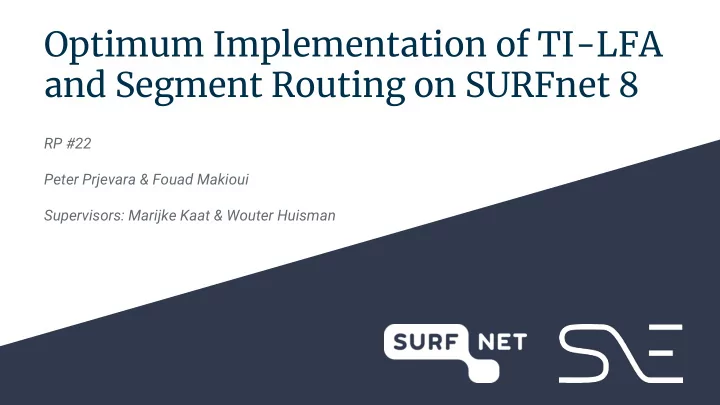

Optimum Implementation of TI-LFA and Segment Routing on SURFnet 8 RP #22 Peter Prjevara & Fouad Makioui Supervisors: Marijke Kaat & Wouter Huisman
The Goals of Networks ARPANET - 1974 2 https://en.wikipedia.org/wiki/ARPANET
What IGPs Currently Offer? ● Sub-second convergence times (< 1000ms) ○ If effects BGP -> can take up to 3 minutes ● Reactive Approach ○ Fault Recognition ○ Information Flooding 3 Source: T Anji Kumar and MHM Prasad. Enhanced multiple routing configurations for fast ip network recovery from multiple failures.
The Goals of Networks Today ● Real time services ○ VoIP / Video ○ Cloud Software ○ Financial Trading ○ Experimental Where might virtual reality lead us? Not good enough David Ramos/Getty Images 4
Network in a Normal State 5
Failure Occurs 6
The Reactive Approach: Step 1 7
The Reactive Approach: Step 2 8
Segment Routing (or SPRING) ● Every node is labelled ○ Node ID ● Every link is labelled ○ Adjacency ID ● MPLS labels ● IGP to distribute Segment IDs (SIDs) creating a full mesh 9
Protective Fast Reroute Solutions rLFA TI-LFA Point of Local Repair 5 (PLR) 5 5 6 100 5 5 Juniper Networks, 2017. Juniper Tech Library - Fast Reroute Overview. 10
Feature Link / Node Protection 11
Link Protection 12
Node Protection 13
Link / Node Protection Summary 14
Fate Sharing 15
16
SURFnet8 Topology ● Interfaces that share the same fate due to: ○ Line card sharing ○ Optical path sharing ● Juniper Routers used that support: ○ TI-LFA ○ SPRING ○ Node Protection ○ Fate Sharing 17
Optical cable sharing Line card sharing 18
Research Questions 1. How do different TI-LFA configurations perform when implementing Node / Link Protection and Fate Sharing? 2. How do they affect the proposed metrics in IGP? 3. Is fate sharing necessary for all links that share the same line card or optical layer? 19
Methodology ● Desk research ○ Understand novel concepts ● Define experiments ○ Create topology ● Analyse results ● Draw conclusions 20
Our Test Topology 21
Our Test Topology 22
Our Test Topology 23
Our Test Topology 24
List of Experiments Experiment Sub Experiment Baseline SR Without TI-LFA With TI-LFA Baseline SR with extra hop Without TI-LFA With TI-LFA Multiple link failures with source as PLR With a single backup path With equal cost multi paths With fate sharing Link/Node Protection Observe the routing table on PLR ECMP Metric Calculation Python Script Simulation / Paper analysis 25
Baseline SR ● SR without TI-LFA vs SR with TI-LFA 26
Baseline SR with Extra Hop ● SR without TI-LFA vs SR with TI-LFA (without crosslink) 27
Results 28
Multiple Link Failures 1 29
Multiple Link Failures 2 30
Multiple Link Failures 3 31
Multiple Link Failures 4 32
Multiple Backup Paths Route output 145.125.124.6/32 (2 entries, 1 announced) *L-ISIS Preference: 14 Next hop: 145.125.176.59 via ge-2/3/0.0 weight 0x1, selected Next hop: 145.125.176.18 via xe-2/0/2.0 weight 0xf000 Next hop: 145.125.176.0 via et-1/1/0.0 weight 0xf000 ● Maximum 8 backup paths ○ Equal Cost Multi Path (ECMP) 33
Experiment: Fate Sharing ● TI-LFA with fate sharing 34
Results 35
Multiple Broken Links Average ~500ms 36
Multiple Broken Links Average ~500ms 37
Multiple ECMPs Average ~52ms 38
Fate Sharing Enabled Average ~30ms 39
Link | Node Protection Link protection 145.125.124.6/32 (2 entries, 1 announced) *L-ISIS Preference: 14 Next hop: 145.125.176.59 via ge-2/3/0.0 weight 0x1, selected Next hop: 145.125.176.18 via xe-2/0/2.0 weight 0xf000 Next hop: 145.125.176.0 via et-1/1/0.0 weight 0xf000 Node protection 145.125.124.6/32 (2 entries, 1 announced) *L-ISIS Preference: 14 Next hop: 145.125.176.59 via ge-2/3/0.0 weight 0x1, selected Next hop: 145.125.176.61 via ge-2/3/1.0 weight 0xf000 Age: 51 Metric: 25 40
41
42
43
Discussion ● TI-LFA works well with ECMPs, so ECMPs should be implemented on SURFnet8 ● Node protection effects ECMPs ● If fate sharing is enabled, routers might not use the post convergence backup path 44
Recommendations ● Use low metrics on links between core routers ○ Default metric on the daisy chain (default 10) ○ Increase number of ECMPs ● Implement fate sharing ● Do not use node protection 45
Future Work ● Improve failure detection speed ○ Bidirectional Forwarding Detection (1 - 10ms) ● How will SRv6 perform in comparison with SR on MPLS? ○ Currently not implemented yet 46
Acknowledgements ● Special thanks: ○ Marijke Kaat and Wouter Huisman ○ SURFnet Team 47
Q & A 48
Recommend
More recommend